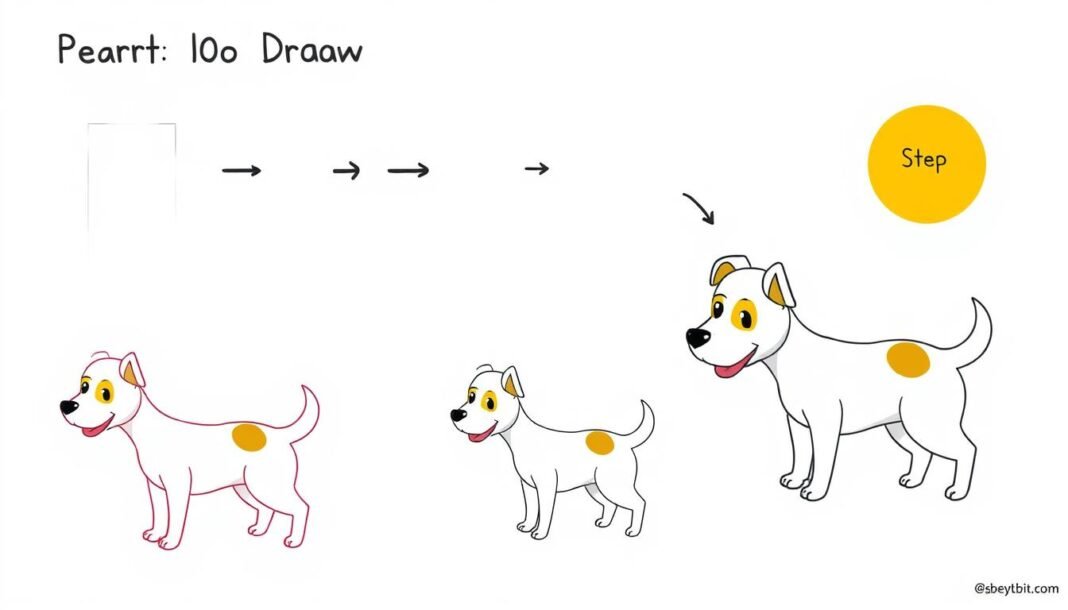Discover the joy of drawing dogs with this simple guide. You’ll learn to capture the charm of our furry friends.
This tutorial works for artists of all levels. You’ll explore dog anatomy and add finishing touches to your sketches.
A step-by-step illustration of a dog drawing process, showcasing simple shapes transforming into a cartoon dog with clear outlines and vibrant colors.
Learn key techniques to bring dogs to life on paper. Create beginner-friendly drawings that show off each dog’s unique personality.
Understanding Dog Anatomy
Dog anatomy is key for artists drawing these beloved pets. Each breed has unique features that show its personality.
The dog’s anatomy includes the head, body, and limbs. These parts create the shape of different canine features.
Breed characteristics vary widely among dogs. German Shepherds have pointed ears, while Labradors have floppy ones.
Learning dog anatomy helps create lifelike drawings. You’ll be able to show the charm of these furry friends.
Gathering Your Materials
The right drawing supplies can significantly improve your dog’s drawings. Quality tools help create stunning canine portraits.
You’ll need a set of quality pencils with various lead types. A good eraser is essential for making corrections.
Choose a smooth, medium-weight sketchbook for your drawings. It should handle different drawing techniques well.
Optional tools can enhance your drawing experience. Drawing guides help capture accurate dog anatomy.
Reference materials provide insights into unique dog features. Photos or illustrations of dogs can be helpful.
Experiment with different tools to find what works best. Your drawing style will guide your choices.
Sketching the Basic Shapes
Drawing a dog starts with basic shapes. Use circles, ovals, and rectangles to create a simple outline.
Begin with the head, focusing on the muzzle, eyes, and ears. Use geometric forms to build these features.
Next, sketch the body, legs, and tail with long shapes. Keep the proportions consistent for an accurate dog outline.
Refine the shapes with subtle curves and angles. This will capture the dog’s unique features.
Pay attention to each element’s placement and size. This creates a balanced and natural-looking dog outline.
Adding Details to the Face
Let’s explore dog facial features. The face shows a dog’s personality. We’ll learn to draw eyes, noses, and ears realistically.
Eyes are windows to a dog’s soul. They show many emotions. Practice drawing dog eyes with care.
The nose is a unique dog feature. Notice its texture and shape. Use shading to show depth.
Ears express a dog’s mood. Try different shapes and positions. This helps create various canine expressions.
Mastering dog facial features opens up new art possibilities. You’ll create lifelike dog portraits that impress others.
Outlining the Body Structure
Drawing a dog starts with understanding its body structure. Learn the basic principles to create realistic, well-proportioned drawings.
Imagine the dog’s body as interconnected shapes. The head connects to the neck, flowing into the chest and abdomen.
Position the legs to support the body. This keeps the drawing balanced and stable.
Include the tail, an essential part of dog anatomy. Place it correctly to complete the overall structure.
Pay attention to proportions and angles when sketching. Size the legs correctly in relation to the body.
Define the joints clearly. The tail should blend smoothly with the body.
Focus on these key elements to capture the essence of canine form. Your drawings will show the actual shape of dogs.
Texturing the Fur
Let’s focus on making the dog’s fur look real. The fur’s texture can make your drawing stand out.
Study the dog fur texture of the breed you’re drawing. Look at pictures to see how the fur looks.
“Close-up of realistic dog fur texture, showcasing a blend of soft, fluffy strands and sleek, shiny hairs, with varying shades of brown, black, and white, highlighting the details of individual fur fibers and their natural patterns.”
Use short, overlapping strokes to create fur texture. Mix this with hatching to build up the fur’s look.
Add highlights and shadows to give depth. Use light touches to shine and darker ones to shadow.
Keep practicing different shading techniques. This will help you find what works best for you.
Bringing the Dog to Life: Colors
Coloring your dog drawing brings it to life. Learn about coloring techniques and dog coat colors.
Blend colors to add depth to the dog’s fur. This makes it look more natural and lifelike.
Study different dog breeds and their unique coat colors. Each breed has its special coloration.
Layer and blend colors to capture your dog’s coat details. This will make your drawing more visually appealing.
Observe and copy the natural patterns in a dog’s fur. Use reference images to help you.
Try different coloring tools and enjoy the process. With practice, you’ll create lifelike dog drawings.
Adding Personality: Expression and Action
Bring your dog drawing to life with personality and movement. Capture the correct expressions and poses to make your canine creation shine.
Show a range of emotions in your pup’s face. Highlight your dog’s unique character and breed-specific traits.
Master the art of capturing movement in your drawings. Study dog anatomy and movement patterns to create dynamic poses.
Each breed moves in its way. Use this to make engaging and lifelike compositions.
Blend expressive faces with captivating poses for vivid masterpieces. Translate a dog’s character and energy onto the page.
Practice and experiment to develop your skills. You’ll soon capture the true spirit of your canine subjects.
Final Touches: Refining the Drawing
It’s time to add the final touches to your dog drawing. Refining your work will create a polished, professional-looking piece.
Look for unnecessary lines in your drawing. Use a kneaded eraser to remove stray marks.
Check the proportions of your dog’s features. Make adjustments to ensure they are in perfect harmony.
Consider adding background elements to your drawing. This could be a plain backdrop or a more elaborate setting.
Try different techniques like shading or adding textures. These can bring your background elements to life.
Patience and attention to detail are key to art refinement. Take your time and make thoughtful adjustments.
With practice, you’ll create stunning dog drawings. Trust your instincts and watch your art improve.

Practice Makes Perfect
Improving your dog’s drawing skills requires regular practice. Dedicate time each day to honing your craft.
Try sketching quick studies or working on detailed drawings. Experiment with different dog breeds to understand canine anatomy better.
Find inspiration to keep your artistic momentum going. Browse online galleries, art books, or reference photos.
Draw from life when possible. Observe the natural movements of dogs around you.
Progress takes time and patience. Celebrate small victories and learn from mistakes.
With consistent drawing practice, you’ll improve at capturing any breed variety. Keep an open mind and explore new art exercises.
Troubleshooting Common Mistakes
Drawing mistakes can be frustrating, but they’re chances to improve. Seeking feedback from other artists can help you spot and fix errors.
Inaccurate proportions are a common issue in dog drawings. Study reference images and dog anatomy to get the sizes right.
Lack of detail can make drawings look flat. Add textures, shadows, and highlights to bring your dog to life.
Share your work and ask for constructive criticism. The feedback you get can provide valuable insights.
Embrace your mistakes and stay open to learning. This approach will help you grow as an artist.
Showcasing Your Artwork
You’ve drawn a fantastic dog. Now it’s time to show it off! Sharing your art can inspire others to create, too.
Online art platforms are great for showcasing your work. Instagram, DeviantArt, and Behance help you build a portfolio.
These sites let you connect with other artists. You can get feedback and find work opportunities.
Make your online portfolio look good. Organize your dog drawings by theme or style.
Interact with other artists online. Comment on their work and join art challenges.
Share your creative process with your followers. This helps build a connection with your audience.
FAQ
What are the basic shapes to start a dog drawing?
Start with circles and ovals for the dog’s head and body. These shapes form a base for adding more details later.
How do I draw realistic-looking dog fur?
Use shading techniques like hatching and stippling for different fur textures. Add lighting and shadows to make the fur look 3D.
What drawing materials do I need to get started?
You’ll need pencils (HB, 2B, 4B), an eraser, and smooth drawing paper. Optional items include reference photos and colored pencils for adding color.
How can I capture a dog’s personality in my drawings?
Focus on the dog’s facial expressions and body language. Pay attention to breed-specific traits and show different emotions.
What are some common mistakes to avoid when drawing dogs?
Watch out for wrong body proportions and flat expressions. Check for incorrect anatomy and uneven fur textures.
How can I improve my dog drawing skills through practice?
Sketch different dog breeds and try new drawing techniques often. Join art groups or take classes to get feedback.
You may also read: Wayward Lanscape Duchamp: A Modern Art Mystery



